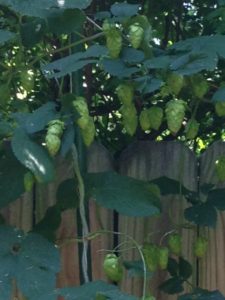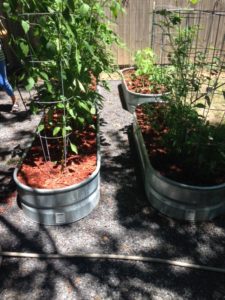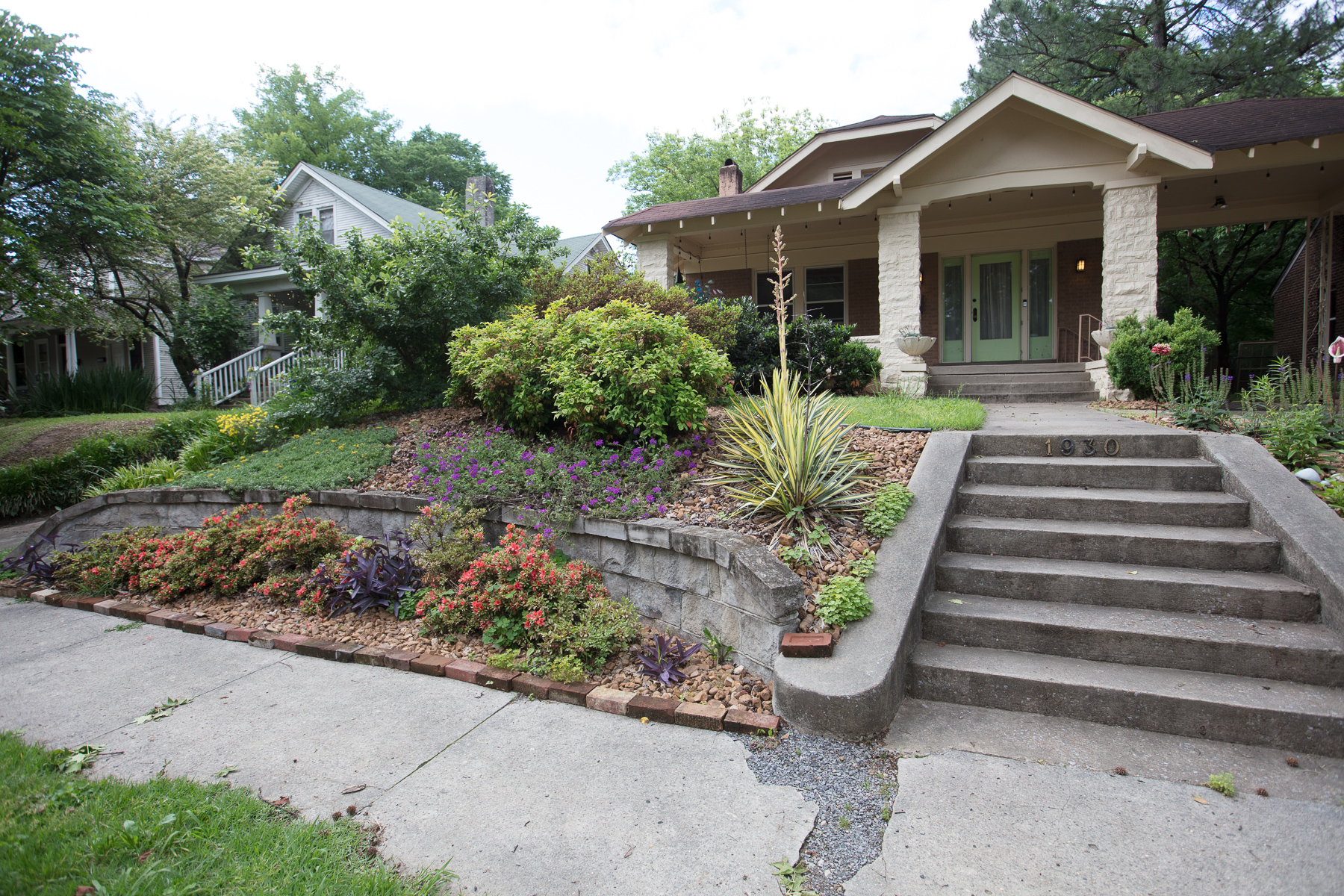We are in full swing of the “dog days” of summer and watering plants everyday can be ritualistic drudgery. July 3rd-August 11th is the official slot frame of the dog. The “dog days” is named after the Dog Star rising, Sirius. It’s the brightest star in the constellation Canis Major. According to the ancients, the rising Dog Star added with the sun made the weather hotter. More humidity, less rain and hotter temps makes it hard to enjoy the gardens here in the mid south. At least the tomato patch is still producing.
Tomato, tomato, however you pronounce it still means the same. Xeriscaping and zero-scraping is practically the same animal. When one thinks of xeriscaping, a desert, cacti laden commercial median strip covered with gravel pops into the mind’s eye, especially the further west one travels, like west Texas, Arizona and New Mexico.
Xeriscaping type landscapes reduces and sometimes eliminates the need to water and is usually promoted in areas where water is at a premium. Wikipedia says, “The term zero-scaping or zeroscaping is sometimes substituted for xeriscaping due to phonetic similarity. When used seriously, zero-scaping usually refers to a different type of low-water landscaping that is often devoid, or nearly devoid of plants.” Zen or Japanese meditation falls within these categories. Zen gardens replicate nature in a smaller scale. The use of large boulders represent mountains with gravel replicating land. Earlier Zen mainly used gravel because it is less disturbed by the elements. Later forms of Zen includes the use of sand. It depicts flowing water in a still life impression. Rakes are used to create designs and a meditative state while creating visual thoughts.
I’m a fan of low maintenance gardens. The use of gravel has become my new mantra in my own garden, so while I was putting entry forms on doors of the possible Cooper Young garden tour participants early this spring, I fell in love with 1930 Oliver. This garden has created a xeriscaped example that also reflects the southern delta.
This is a beautiful landscaped example of low water dependency.
This part of CY is prevalent with larger two story homes along with bungalows. Located at the end of a long block, this bungalow was built in 1922. It is nestled amongst its own ilk and shines like Sirius. It’s even perched upon a high hill, closer to the full south facing sun, if you will.
Approaching the garden there is a grass parkway from the curb to the sidewalk. Just off the sidewalk is a carved out semicircle retained by manufactured stacked stone that replicates the carved limestone on the house. A gentle slope at each side is symmetrical and pleasing visually. This wall runs the width of the front yard. The swath of land at grade level is filled with azaleas and a brown washed river rock. A strip of reclaimed bricks define the rocks edge. This rock is used as mulch throughout the front. The rest of hill above to the porch is filled with green plantings and a Chinese Fringe tree. All is spaced where the stones are the Sirius. Variegated yucca guard the massive grand staircase leading guests up toward the front porch. On the right is a narrow patch of land between the entrance sidewalk and the driveway where a butterfly garden containing milkweed, salvia and cornflower has been added to greet all that enter. Then a wide path of reclaimed bricks were developed into a spot to enter the garden from the huge carport. The opposite side of the bricks is a carpet of grass. The semicircle shape replicates the retaining wall. Repetitive patterns is Zen like. The stone porch posts and carport are massive and the retaining wall matches it nicely. A whirly gig with a rainbow of colored glass is a nice but not an overbearing addition. Bungalows have large porches, just as this one does. The brick and stone have been painted. Vanilla is the color of all the trim and the house a putty gray. The front door has the traditional glass door flanked by two sidelight panels. A contemporary green is the door’s hue. Next stop, the back garden.
Coming out the back door, a low slung deck without handrails eases across the entire back of the house. A minimalist approach is used throughout this garden with its plantings and fixtures. The large deck is equipped with a table for two. As you gaze out the back there is a long shot vision the homeowners considered while developing this garden. I get a zero-scape impression from the view.
The step down to the yard is one step edged with crushed limestone and a brick edge. To the right is a board fence with more of the brown stone. It takes you to a couple of planter pots containing morning glory and moon flower. A Chinese Fringe tree is immature but will develop nicely. Beyond on the side is a large pine tree creating shade where needed, on the house and deck. All the surrounding neighbors yards have large trees that provide shade that encircles the entire back garden. Where there is full sun there is grass and a raised garden for veggies so the light can be taken advantage of. The veggie garden containers are animal water throughs. There are four filled with tomatoes, peppers, red runner beans and okra. Behind the troughs is a storage building and a repurposed plastic mini shed that has been turned into a composter by drilling large holes in its walls to drain and capture air. All of the back, including the veggie garden is mulched with a silver crushed limestone that creates a working area for ascetics and function. Deep shade prevents grass growth. A hammock and a concrete low slung table is perched in the center. The northwest corner of the garden is dedicated to plants and more washed brown river rock. The two color and types of stone marry into a well thought out production. The plants are minimum as in the front yard. Azaleas, Japanese coral bark Maple, coral bells, Lenten rose and ferns spread out like a stretched set of fingers. As we saunter around to conclude our tour there is a yet more of the brown river rock continuing around to a hop plant. It is stretched on a line to the top of the fence like an umbrella frame. A little whimsy is added in the middle of the hops. It’s a silver fire plug. Maybe it’s for Sirius to align to.

Matt Barrett and Trevor Robinson, how long have you two been living at 1930 Oliver?
“We have been living at 1930 Oliver for a little over two years now. We closed on the house in June 2015 and were both excited to be first-time home owners.”
What attracted you to CY and this house?
“Before we settled on CY as where we wanted to buy a house, we lived alone and together in Downtown Memphis, East Memphis, and almost every area in-between. The unique housing architecture, large tree canopies, and eclectic yards attracted us to the area. The walkability to restaurants and bars such as Celtic Crossing, Mulan, Aldo’s and Memphis Made, and the relatively short commute to work were big positives for buying a house in the area as well.”
“We looked at several houses in the area before seeing 1930 Oliver. Our real estate agent, Katie Cook, told us that when we found the one, we would know. When I first walked into the house and saw the natural wood finish in the living room and dining room, I thought to myself, “This might be it.” We also liked the design of the front yard with the retainer wall and minimal grass yard area.”
Are you both from Memphis or are you all transplants? (plant humor)
“We are both transplants. I am from Booneville, MS in Northeast Mississippi. I moved to Memphis in 2008 for work after graduating from the University of Mississippi with a Master in Accountancy. Trevor is from Rockford, MI, close to Grand Rapids. He moved here in 2007 for work after graduating from Western Michigan University with a Bachelor in Computer Science.”
What are both of your professions?
“We both work at the AutoZone Store Support Center in downtown Memphis. I’m a Senior Financial Analyst in Inventory Finance, and Trevor is an IT Systems Engineer in Information Security.”
Tell the readers what your property was like when you moved in.
“When we moved in, the backyard was a blank slate (for better or worse) – no plants except for one apple tree and one Japanese maple. Also in the backyard, we had no deck, a raised garden structure in the center of the yard, and all the previous landscaping had been taken over by grass or was just bare dirt.”
“The front yard had been re-mulched and weeded, but the apple tree in the front was starting to fall over. We knew that we wanted to replace the apple tree that was falling over in the front yard, but we weren’t sure with what – a different tree, a shrub, or flowers. While browsing around Urban Earth one Saturday, we spotted a Chinese fringe tree and knew it was the one. Before that, I had only ever seen/heard of a Chinese fringe tree because of the one on Nelson. We hope the one in our yard turns out as beautiful as the one on Nelson.”
 You have a veggie garden in troughs. What made you choose this type of vessel, and how is it working out?
You have a veggie garden in troughs. What made you choose this type of vessel, and how is it working out?“We wanted a replacement for the raised garden structure that was in the center of the backyard. The raised garden was becoming sort of an eye sore. John, the manager at Urban Earth, suggested the troughs for the replacement veggie garden. On a Saturday afternoon, Trevor and I rented a truck from U-Haul, bought the troughs from TSC [ Tractor Supply Company] in Southaven, drilled some drainage holes, and filled them up with a mixture of soil and compost. So far, they are working out great, and I like the look. I might paint them in the near future.”
How would you describe your garden style and what or who was the inspiration?
“In the front yard, we focused on low-maintenance, drought tolerant, full sun perennial plants, so in a sense, a xeriscape. The brown gravel/river stone was inspired by the general landscaping choices in Michigan, Trevor’s home state. It seems like a lot of people in Michigan use river stone in their landscaping in some way – whether as an alternative to mulch or as an accent, at least, what I observed. We also liked the idea of not having to replace mulch every year and mulch can attract termites.”
Red runner beans and hops are two of the plants choices. Tell us why?
“We subscribed to a quarterly bean club, Rancho Gordo. One of our favorite beans that we discovered from the bean club was the scarlet runner bean, so we decided to try to grow it in the garden. We love adding it as part of a chili stew; it’s so meaty. Another benefit of the scarlet runner bean is that it is known for its flowers that attract hummingbirds.”
“We like to make home brewed beer, so about four years ago we thought it would be neat to grow a hop plant. The hop flowers are used for bittering beer. Once a year, we use our harvested Columbus hops in a home brewed beer. It makes for a good story and a good beer.”
Any hobbies, groups or passions?
“Apart from just getting involved in the Cooper Young Garden Club, I have been serving on the Outflix Film Festival Committee for the past year and a half. Outflix showcases LGBTQ films and is a fundraiser for OutMemphis, an LGBTQ center for the Mid-South. This year is the 20th anniversary for the festival, and we are very excited. The week-long festival kicks off September 8th.”
“Trevor and I home brew a variety of styles of beer and mead. One of our favorites for a long time was a hibiscus-ginger Saison. Once a year, we brew an anniversary barley wine. We have slowly moved from extract brewing to all-grain brewing
“We play a variety of board games with friends and take part in a weekly Dungeon & Dragons campaign.”
How long have you been gardening?
“We have been gardening for about 4 years. The first year, we grew 10 Roma tomato plants in pots. That year, we had 2 good harvests and canned the tomato juice. The first year we bought the house in CY, I attempted a garden but the squirrels, birds, and rats ate any vegetable that started to grow. This year, I learned my lesson and put up netting to deter neighborhood critters.”
Future plans for your space?
“Our space is a work in progress. We want to finish up the landscaping on the back west side of house. I also want to place a ground cover plant on the east side of the drive way and on the west side of the front hill. Other than that, we are ready to enjoy the backyard space!”
What is your favorite part of your space and why?
“We have two favorite spots. When we come home from work, we enjoy being welcomed by the butterfly garden in the front yard. After weekday dinners and on the weekends, we like to enjoy the newly landscaped backyard with family and friends. The backyard landscaping under the tree canopy offers a relaxing area for a game of Giant Jenga, a game of badminton, or just good conversation.”
